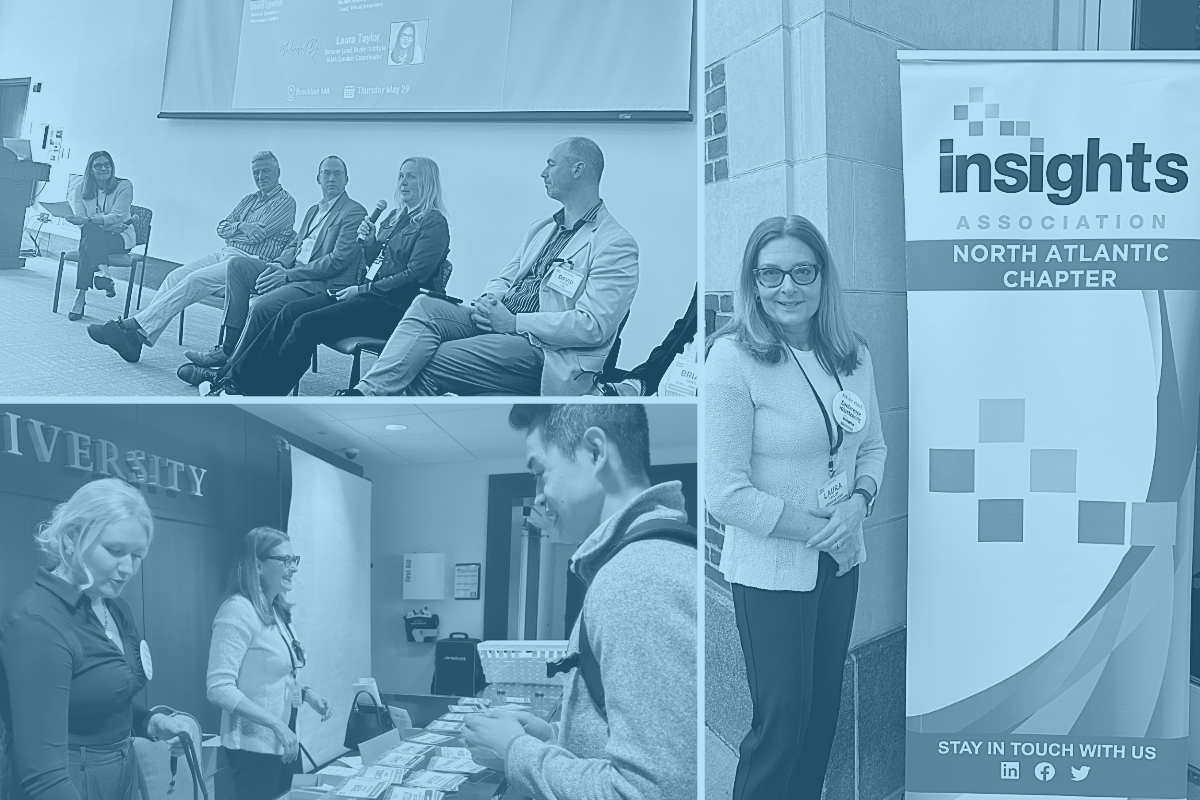For example, we led a global personal care brand through the process of assessing several personal care subcategories for transformative growth. Our work included an assessment of the viable targets, their need states, product trends in the market, the available technology at the client’s disposal and the anticipated environment in their global markets, to arrive at innovation ambitions that could be supported both centrally and in the brand’s many regions.
How research can guide the innovation process
by Eric Tayce
On the surface, innovation may be construed as a purely creative exercise; gathering people in a room to brainstorm new, pie-in-the-sky ideas. However, successful innovation – the kind that delivers breakthrough growth for a business – requires an intentionally people-centric approach to decoding consumers’ future needs and desires, leading to ideas that not only meet those needs but also strategically build upon the brand’s existing strengths.
Executing that ideal image of an innovation process can feel overwhelming – unless, that is, research is deliberately leveraged at every step. The most successful innovation efforts place the entire team’s focus on the intersection of creativity and human insight; relentlessly searching for what’s real and relevant to the consumer target through every step of the process. As researchers, our role on an innovation team is to provide the data-driven foundation for the creative process, from beginning to end, untangling the intricacies of human behavior, emotions and needs to form the compass that keeps innovation pointing squarely towards the consumer.
A typical innovation process usually involves four phases: landscape assessment, ideation, optimization and launch. Research insights are most often visible in the concept optimization phase, after initial ideas have been sifted and taken shape. These insights are most often in the form of concept tests, feature and price optimization, claims and package testing and so forth. However, to infuse a truly people-centric perspective into an innovation process, research should serve a critical role in every phase – particularly in the landscape assessment, or what’s also known as the “fuzzy front-end,” where ambiguity abounds.
In this initial phase of innovation, the researcher’s intent should be to keep the people you are trying to serve in the forefront of the conversation, while confirming the financial value to the businesses. Research holds particular power at three unique points: illuminating a clearer view of fuzzy future opportunities; providing data-inspired projective consumer profiles; and maintaining human centricity by injecting consumer input.
Illuminating a clearer view of fuzzy future opportunities
Setting clear ambitions for innovation starts with outlining the opportunity landscape. This begins with a thorough audit of what we know and the development of a common “source of truth” about the business, the market and consumers – where they’ve been and where they are going. An audit also identifies any relevant knowledge gaps or unseen areas that may exist. Absent this foundation, innovation efforts can move in too many directions and fail to focus on (and find) the prize.
To evaluate opportunities identified in the landscape assessment, it is important to examine both external and internal forces that impact the success of the business. External forces involve the market, the competition, economic outlook, category trends and other information found in market assessments, trend reports, syndicated research and other sources of market intelligence. Internal forces involve examining the brand’s strength and determining how far the brand can push innovation in the directions where success is most likely to happen.
Existing research can be very helpful in this effort to evaluate opportunities by providing insight into relevant consumer needs – referencing consumption audits, brand performance monitoring, segmentation, attitudes and usage, qualitative and more. However, data, while plentiful, is often insufficiently meaningful, of poor quality or not well-connected. It takes a collaborative approach between marketing strategists and researchers to effectively filter the trove of consumer, company and market context information into intentionally focused areas with the greatest potential impact for the business.
Advancements in generative AI are poised to accelerate the process of distilling and analyzing broad sets of disparate data sources – when used with proper testing for validity and reliability. Additionally, agile methodologies can provide efficient ways to fill knowledge gaps or add the voice of the consumer into these up-front foundational elements.
Regardless of what information, technologies or methodologies are available, every innovation effort needs to begin by setting a clear, data-informed goal for what success looks like for the business at hand.
Providing data-inspired projective consumer profiles
Companies, in the development of new solutions, often use segmentation research to help set their targeting strategy. The outcome of this research, the segments, provides direction for business activity driving acquisition of new customers and penetration of existing ones. Segments can be tremendously useful to hone efforts for closer-in innovation efforts but they tend to fall short of providing a future-focused market view that leads to the development of long-range innovation pipelines. This is especially true if the segmentation research is not refreshed every few years. Absent this, the business will lack long-range design targets that further sharpen the execution of future-forward innovation ideas.
Steering ideation to meet the needs of future consumers requires the innovation team to use existing market segmentations as a starting point for building projective consumer profiles that represent the potential consumer of the future. Complementing or extending existing segmentations with sales data, social media insights, other available secondary information, and/or using demand space segmentation if it is feasible or relevant, can help identify opportunities and new projective consumer profiles to serve.
One productive way these profiles may come to life is through the development of personas. A persona is a semi-fictional archetype that represents the key traits of a consumer group by combining demographics (age, gender, location), psychographics (attitudes, beliefs, lifestyle) and inferred perspectives (motivations, needs, tensions) to build lifelike characterizations that are action-oriented and inspiring to innovation teams.
Unlike a segmentation, which defines consumer groups based on behaviors, attitudes or needs, a persona imagines the personal qualities of a consumer group based on why they behave and feel a certain way, which ultimately fosters the inspiration and emotional empathy required for breakthrough innovation. As researchers, we contribute a consumer-informed, data-first perspective in the development of plausible projective personas, versus simply imagined or unrealistic ones, to continually keep innovation efforts centered on the human experience.
As an example, when we were tasked with helping a global food company with its innovation efforts in Africa, we used existing research bolstered by qualitative to develop personas that represented different groups and their attitudes towards nutrition. We profiled consumers based on their core personal motivations (learning, finding oneself, caring for others, etc.), their challenges with nutrition, their attitudes, beliefs, usage of packaged foods and what their typical day looks like. The distinct personas were brought to life with imagery and quotes to help the team put themselves in the shoes of the consumer in an unfamiliar market, allowing them to imagine how the consumers’ needs might change over time.
Maintaining human centricity by injecting consumer input
Even the most well-meaning innovation efforts can fall victim to what is known as “innovation theater” – relying on “shiny” innovation activities that may feel like progress but in actuality lack a strategic north star. It’s vital to maintain the discipline to focus on real consumer needs and business opportunities, especially as the creative elements of the process step into the spotlight.
Consumer insight can be incorporated into creative processes subtly yet powerfully, through touchpoints like innovation platforms or ideation activity design. However, elevating the consumer voice even further, consumers can be brought into the process as sounding boards to help gauge hypotheses, course-correct propositions and ultimately ensure ideas are laser-focused on true, relevant insights and needs.
As a research partner to innovation teams, recommending the best methodologies to engage consumers to enable this learning can illuminate opportunities to strengthen the process and ensure ideas will generate business growth. A wide variety of qualitative techniques can be deployed, even in the early stages of idea development, using approaches like ethnographies, online communities and side-by-side co-creation workshops.
For example, when a pet-treat company could feel its leadership position slipping as new entrants made inroads, we used consumer feedback to home in on key areas that were being missed by the competition to develop powerful innovation platforms. These insights found their way to strategic ideation sessions, and ultimately, a range of products that amounted to an innovation pipeline of launches in key markets around the world lasting more than five years.
Real and relevant needs
What sets winning innovation apart is the ability to bring the human perspective into the process, from beginning to end. At the start, adopting a people-centric perspective helps to set a solid foundation for the innovation effort – rooting the project ambition in real and relevant needs and empowering the team to make informed decisions on what is needed to grow the business. As researchers, we can partner with marketing and innovation teams to look deeper at existing segmentation data to create a more humanized representation. Doing so not only brings to light pointedly relevant information but also breathes relatability into targeted consumer groups in order to inspire the empathy necessary to innovate. And finally, the consumer should remain front-and-center, even in the more creative legs of the process, inspiring processes, interjecting feedback and navigating towards the richest potential opportunities. When research insight is combined with creative and strategic inputs, companies gain true foresight and have a formula for breakthrough innovation.
This article was originally published in Quirk’s magazine.

Eric Tayce is VP, Innovation Solutions at Burke. With over 20 years in the industry, Eric has experience that spans the entire research process from the perspectives of both a supplier and a client. Eric’s expertise covers many business issues, with particular emphasis on brand equity, brand image and positioning, segmentation, and product optimization.
As always, you can follow Burke, Inc. on our LinkedIn, Twitter, Facebook and Instagram pages.
Source: Feature Image – ©khwanchai – stock.adobe.com








